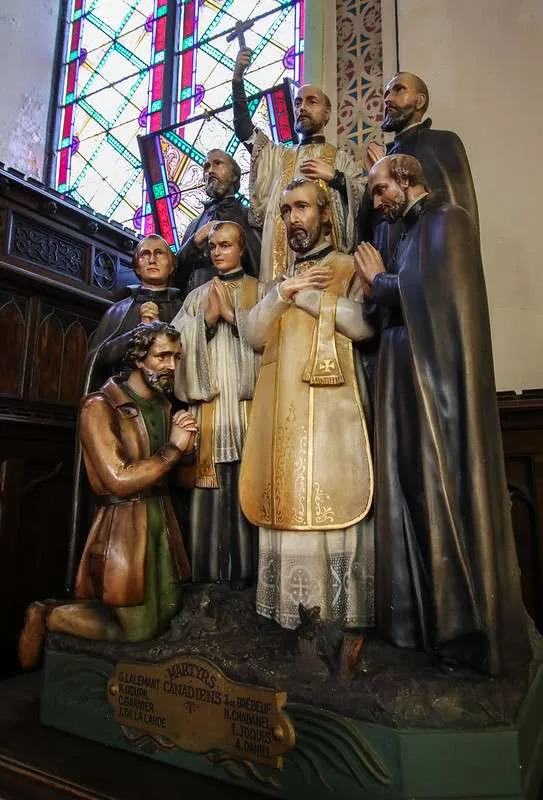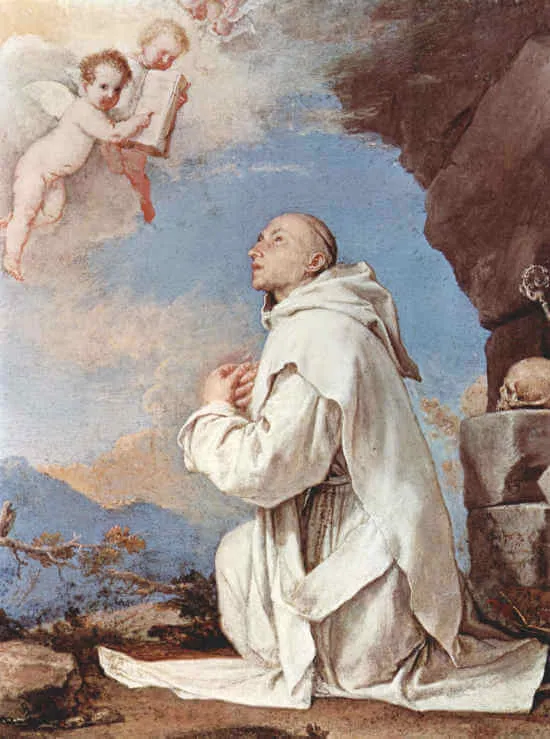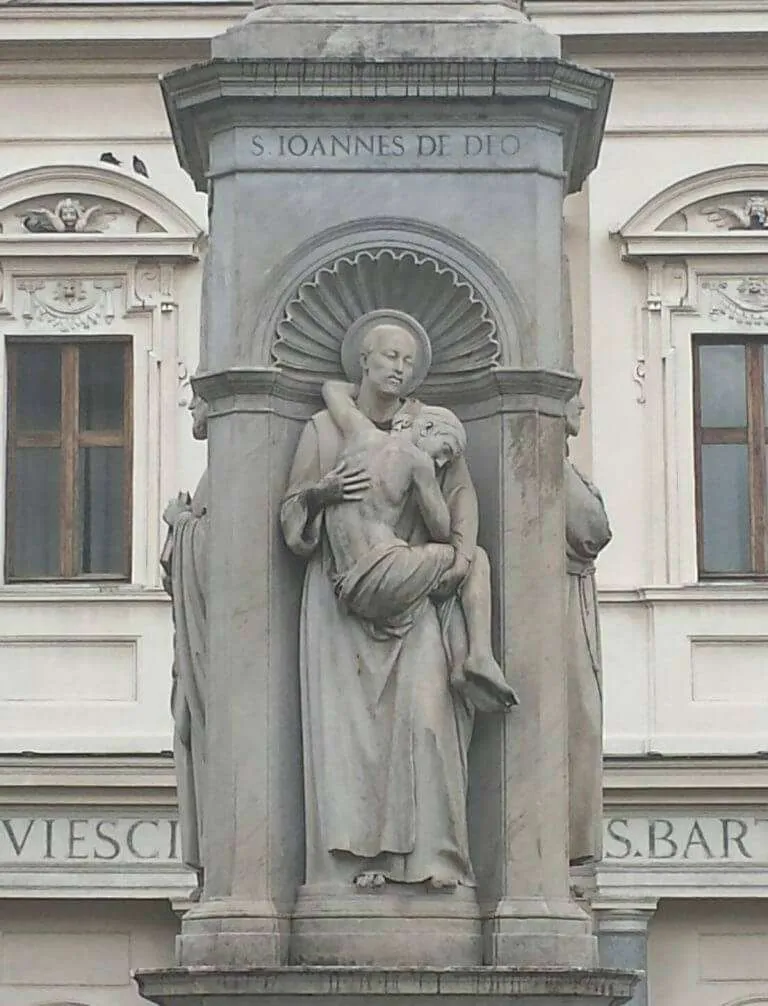Saint René Goupil (1606–1642); Saint Isaac Jogues (1607–1646); Saint Jean de la Lande (Unknown–1646); Saint Antoine Daniel (1601–1648); Saint Gabriel Lalemant (1610–1649); Saint Jean de Brébeuf (1593–1649); Saint Charles Garnier (1606–1649); Saint Noël Chabanel (1613–1649); Patron Saints of North America; Canonized by Pope Pius XI on June 29, 1930
In the early seventeenth century, Dutch explorers made first contact with the Iroquois Confederacy in modern-day Albany, New York. The Confederacy was a political and military alliance of six Iroquoian-speaking native tribes located primarily in modern-day New York State. It was formed for inter-tribal security, diplomacy, and governance based on the tribes’ Great Law of Peace. The participating tribes were the Mohawk, Oneida, Onondaga, Cayuga, Seneca, and Tuscarora. The Dutch, and later British, engaged in fur trading in exchange for European items, such as metal tools, firearms, and alcohol.
Around the same time, French explorers came into contact with the Huron-Wendat Confederacy, who were continually at war with the Iroquois. Tensions between the two native confederacies centered around disputes over hunting grounds and trade routes associated with their new European alliances. The French were unique among the European settlers in that—in addition to establishing trade, political, and military alliances—they also sought to share the Gospel of Jesus Christ with the natives. The Jesuits were the driving force behind that work of evangelization. Though the French did establish some relations with the Iroquois Confederacy, their alliance with the Huron-Wendat Confederacy led the Iroquois to distrust the French and remain at war with the Huron-Wendat tribes.
When French Jesuits began arriving in North America, their first mission was at Port-Royal, Acadia, modern-day Nova Scotia. In 1613, a mission was established on the Mount Desert Island of modern-day Maine. In 1625, Notre-Dame-des-Anges was established near modern-day Quebec City, and in the same year, a mission was established at the mouth of the Saguenay River in Quebec. Among the first Jesuits to arrive was Father Jean de Brébeuf, one of more than 100 Jesuits who would arrive in the seventeenth century, eight of whom would die as martyrs.
In 1642, a layman named René Goupil was working as a medic for the Jesuit Missionaries near Quebec and was invited to accompany Father Isaac Jogues and a group of forty others, including Huron-Wendat chiefs, on a missionary expedition. While traveling, the group was attacked by Mohawk members of the Iroquois Confederation and taken to the village of Ossernenon near modern-day Auriesville, New York. Upon being seized by the Mohawks, René cried out to Father Jogues, “O my father, God be blessed; He has permitted it, He has willed it—His holy will be done. I love it, I desire it, I cherish it, I embrace it with all the strength of my heart.” Once captured, they were cruelly tortured, their fingers crushed and fingernails torn out. Father Jogues continually encouraged his companions, baptizing an elder Huron, hearing René’s confession, and preparing them for death. Years earlier, René had entered the Jesuit novitiate but had to leave because he suffered from deafness. Once captured, however, René made the Jesuit profession and was received into the order as a lay brother by Father Jogues on the spot.
Over the next six weeks, the tortures continued with beatings to the point of disfigurement. The captives’ fingers were cut off, and they were abused every day by numerous Mohawks within the camp. On September 29, Father Jogues and Brother René were walking in the village when two young Iroquois men told them to follow them. They did so, sensing this was the end. Suddenly, one of the Iroquois men turned and tomahawked Brother René in the head. He was the first Jesuit to be martyred. Father Jogues later learned that Brother René was killed because an Iroquois elder witnessed Brother René making the sign of the Cross on the forehead of an Iroquois child, and ordered his execution.
After more than a year in captivity, Father Jogues was able to escape and make his way back to France with the help of a sympathetic Mohawk and Dutch settlers. He was given a hero’s welcome in France, and Pope Urban VIII gave him permission to celebrate Mass, despite losing his fingers. At that time, the Blessed Sacrament could only be touched by the thumb and forefinger. In 1644, after being back in France for a year and a half, Father Jogues returned to the missions, desiring to continue the work and to accept martyrdom if God willed it. In 1646, he returned to the place of his previous captivity with Jesuit lay brother Jean de Lalande. Father Jogues’ desire was to establish peace with the Iroquois so that the Jesuits could continue their work of evangelization. He believed he was in a unique position to establish that peace. As they journeyed, they were captured and brought back to the same village of Ossernenon. This time, the Iroquois only kept them captive for a short period of time before Father Jogues was tomahawked in the head and beheaded on October 18, 1646. The next day, when Brother Jean de Lalande went to tend to his body, he was also martyred.
The other martyrs we honor today are Saints Antoine Daniel, Gabriel Lalemant, Jean de Brébeuf, Charles Garnier, and Noël Chabanel. Father Jean de Brébeuf arrived in New France and settled near Quebec in 1625 where he learned the Huron language and wrote a catechism in Huron, as well as a French–Huron dictionary for use by other Jesuits. In 1639, Father de Brébeuf, along with other French Jesuits, settlers, and soldiers, traveled farther west, down the Saint Lawrence River, deeper into Huron-Wendat territory and settled on the eastern side of Lake Huron, near the town of Midland, Ontario, Canada, to establish a Jesuit mission named Sainte-Marie among the Hurons. It was the first European settlement in modern-day Ontario. Sainte-Marie served as a central Jesuit mission to the Huron-Wendat Confederacy and as a headquarters for Jesuit activities in the area. From it, smaller missions were established in the area.
Each of the five remaining Jesuits was martyred in 1648–1649 at the missions served by Sainte-Marie. Father Antoine Daniel was captured at the Saint-Joseph mission on July 4, 1648, just after celebrating the Holy Mass. He was still in his vestments when he was shot with arrows and then burned in the chapel. Fathers Gabriel Lalemant and Jean de Brébeuf were serving at the Huron-Wendat village of Saint-Louis when it was attacked by the Iroquois on March 16, 1649. After several hours of extreme torture, including having hot coals placed on their bodies and being scalped, they died. On June 14, the remaining Jesuits and settlers abandoned and burned the Sainte-Marie Mission, to keep it from being desecrated by the Iroquois, and so they could flee to smaller and safer locations to continue their work. Fathers Charles Garnier and Noël Chabanel fled to Saint-Jean mission, and, despite the deaths of their fellow Jesuits, they continued their work. On December 7, 1649, their mission was attacked, and Father Garnier was shot with arrows and tomahawked to death. Father Chabanel was tracked down and killed; his body was never recovered.
These heroic saints helped lay the foundation of faith not only for the native peoples but also for the European settlers who arrived and populated North America. They epitomize a selfless desire to lay down their lives for others, even those who acted in excessively brutal ways. The torture they received did not lead to bitterness but to praise and thanksgiving to God that they were found worthy to imitate Christ’s death.
As we honor the North American Martyrs, ponder your own depth of sacrifice you are willing to make for the good of those around you. Family, friends, community, or workplace, we must continually look out for the good of others in a selfless way. Seek inspiration from today’s saints and strive to follow in their footsteps, through the unique form of martyrdom God asks of you.
Source: https://mycatholic.life/saints/saints-of-the-liturgical-year/october-19—saints-jean-de-brbeuf-isaac-jogues-and-companions/








